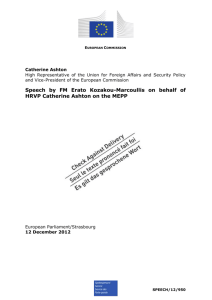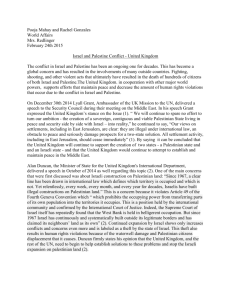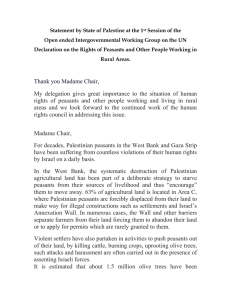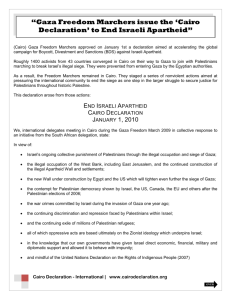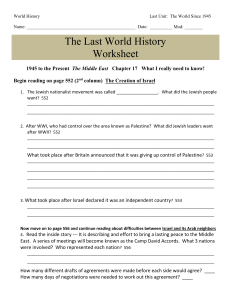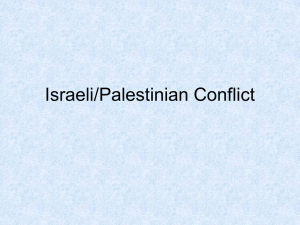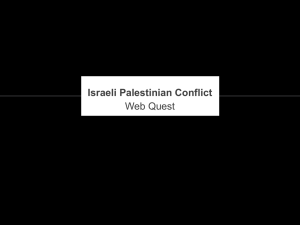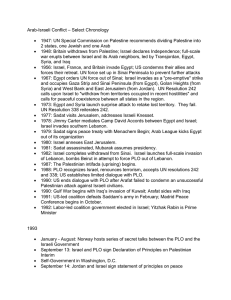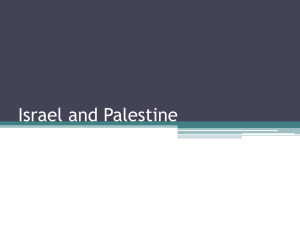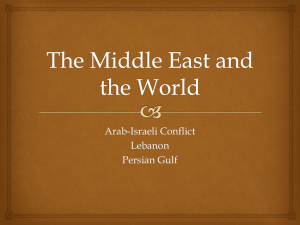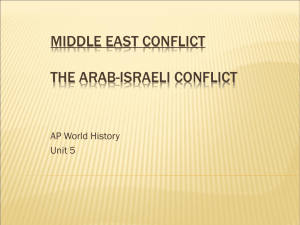Peace process - Canton Jewish Community Center
advertisement
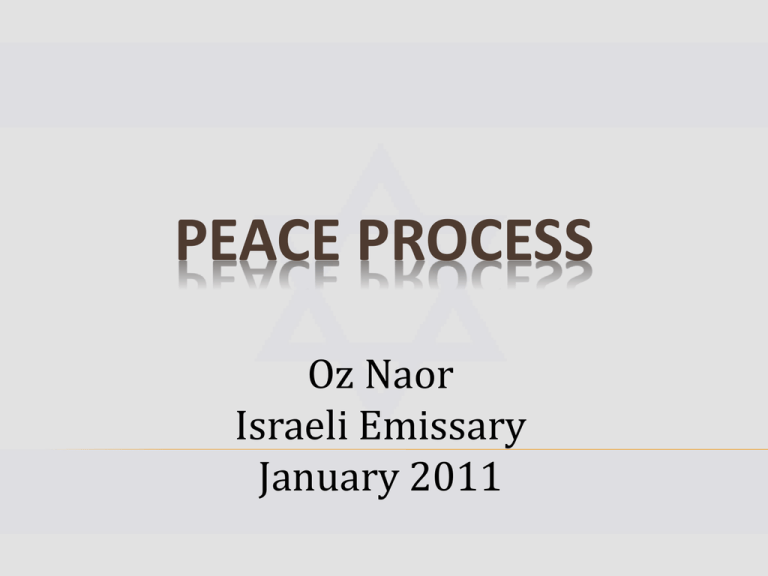
PEACE PROCESS Oz Naor Israeli Emissary January 2011 Israel’s Military Administration of the West Bank and Gaza 1967-1993 After the 1967 war, Israel immediately offered to exchange land for peace. The Arab league’s response, known as the “Three Nos”: “No peace with Israel, No recognition of Israel, No negotiations with Israel.” –Arab League Khartoum Resolution, September 1, 1967 WHEN THE MIND SET CHANGED? The peace process with Egypt. The first gulf war. Madrid Conference in 1991. Governments changed. ISRAEL’S SEARCH FOR PEACE Israel was willing to make territorial compromise to gain peace Since 1937 Israel accepted territorial compromise in 1937, 1947, 1979 and 2000. 1979–Peace with Egypt. Israel returned Sinai. MADRID CONFERENCE OF 1991 The Impact of the Madrid Peace Conference: • Israel's International status has improved and new diplomatic relations were developed with other countries like China, Oman, Qatar, Tunisia & Morocco. • The Madrid Conference also Paved the way for the Oslo Accords and direct negotiation with the PLO. ISRAELI-PALESTINIAN PEACE EFFORTS The Oslo process brought high hopes for Palestinian-Israeli peace, 1993 The PLO’s Yasser Arafat agreed to a Palestinian government in the West Bank and Gaza. Israel agreed to give administrative control to the newly created Palestinian Authority and to progressively withdraw from disputed territory. “Final Status” issues, including final borders, refugees, Jerusalem settlements and security, were to be negotiated at the end of the peace process. 1994–PEACE WITH JORDAN • Discussions began in 1994. Israeli Prime Minister Yitzhak Rabin and Foreign Minister Shimon Peres informed King Hussein that after the Oslo Accords with the PLO, Jordan might be "left out of the big game". • The treaty was closely linked with the efforts to create peace between Israel and the Palestinian Authority. RABIN ASSASSINATION On 4 November 1995 Rabin was assassinated by Yigal Amir, a radical right-wing Orthodox Jew. WYE RIVER MEMORANDUM • The Wye River Memorandum was an agreement negotiated between Israel and the Palestine Authority to implement the earlier Interim Agreement of 28 September, 1995. • With the outbreak of the AlAqsa Intifada in September 2000, the Wye River's understandings and goals remain un-implemented. HOPES FOR PEACE LOST (2000) Hopeful Steps Disappointments PA created as Palestinian civil government. Terrorism escalates– 1993-2000: 282 Israelis killed 1978-1993: 216 Israelis killed Yasser Arafat claims to renounce terror and is elected as President of PA. Anti-Israel incitement mounts in Palestinian media, schools and mosques. 98% of Palestinians governed by PA. Israel delays withdrawals. Israeli withdrawals from 80% of Gaza, 40% of West Bank. No agreements on borders. Israeli communities expand in disputed territories. CAMP DAVID SUMMIT, 11 JULY 2000 The Middle East Peace Summit at Camp David of July 2000 took place between United States President Bill Clinton, Israeli Prime Minister Ehud Barak, and Palestinian Authority Chairman Yasser Arafat. Ultimately, it was an unsuccessful attempt to negotiate a "final status settlement" to the IsraeliPalestinian conflict. CAMP DAVID NEGOTIATIONS FAIL JULY 2000 The Offer 100% of Gaza, 97% of West Bank with land swap for extra 3%. Uprooting Israeli settlements within new PA borders. Shared capital of Jerusalem. $30 billion in refugee resettlement fund. ARAFAT’S RESPONSE: Arafat did not accept the offer, made no counteroffer and walked away from the negotiation. Two months later, he launched the Second Intifada – the terrorist war against Israel THE SECOND “INTIFADA” Sept. 28, 2000-Dec. 31, 2005: 147 suicide bombings 1,084 killed 7,454 injured/crippled 82% of dead and wounded were civilians Targets: restaurants, dance clubs, buses, religious events, shopping malls, civilians in cars ROAD MAP FOR PEACE, JUNE 2003 The "road map" for peace is a plan to resolve the Israeli-Palestinian conflict proposed by a "quartet" of international entities: the United States, the European Union, Russia, and the United Nations. "The Roadmap represents a starting point toward achieving the vision of two states, a secure State of Israel and a viable, peaceful, democratic Palestine. PALESTINIAN PRESIDENTIAL ELECTION, 2005 the first to be held since 1996 — took place on January 9, 2005 in the West Bank and Gaza Strip. Voters elected PLO chairman Mahmoud Abbas as the new President of the Palestinian Authority to replace Yasser Arafat, who died on November 11, 2004. ISRAELI-PALESTINIAN PEACE EFFORTS Post-Intifada Failed Peace Efforts June 2003 Road map to peace August 2005 Israel uproots all Israeli communities in Gaza January 2006 Hamas elected in Gaza June 2007 Hamas coup against Fatah in Gaza ANNAPOLIS CONFERENCE 2007 The Annapolis Conference was a Middle East peace conference held on November 27, 2007 at the United States Naval Academy in Annapolis. The conference marked the first time a two-state solution was articulated as the mutually agreed-upon outline for addressing the IsraeliPalestinian conflict. PROXIMITY TALKS 2010 2010, United States President Barack Obama, Israeli Prime Minister Benjamin Netanyahu, and Palestinian Authority Chairman Mahmud Abbas. The ultimate aim of the direct negotiations is reaching an official "final status settlement" to the IsraeliPalestinian conflict by implementing a two-state solution, with Israel remaining a Jewish state, and the establishment of a state for the Palestinian people. Oz Naor Israeli Emissary 330 316 5699 December 2010
